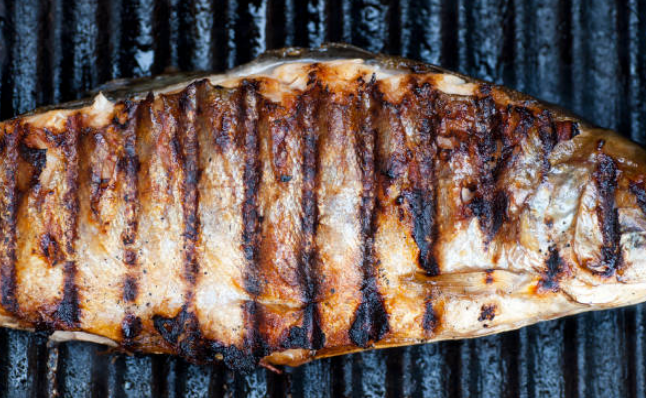
Here is the thing about fish skin—it must be super fresh; any other way, it will have a limp surface that could switch you off of it for quite a while! It’s a cooking procedure that, naturally, threatens a many individuals. With a couple of tips and deceives, you’ll feel like a star in the kitchen and unhesitatingly make delicious skin-on fish filets. In this article, we’ll walk you through the most well-known method for making this kind of fish—searing. We’ll likewise give you an option for cooking the fish to manage a sweltering container
Method 1:
Filets on the Stovetop
- Evaporate the fish skin-side in the cooler for 1 hour prior to cooking it. Put the fish on a spotless dish and leave it revealed in the refrigerator. This interaction dries the abundance dampness so the skin gets very fresh.
- This cycle works for a wide range of fish, yet salmon, branzino, ocean bass, mackerel, struggle, or snapper will taste the best. Their skin gets super fresh under high hotness and has an incredible flavor.
- Dampness is the adversary of fresh skin. In the event that the fish is too wet when it hits the skillet, your filet will steam and conceivably stick and tear when you attempt to flip it. You can likewise wipe the skin off with paper towels in the event that you neglect to prepare it on schedule. Allow the fish to come to room temp for 15-20 minutes. An aloof person makes more steam when it hits the container, making it harder for the skin to fresh up. In the wake of drying the fish in the refrigerator for 60 minutes, move the plate to the counter so it can heat up.
- Heat a tempered steel skillet over high hotness for 2 minutes. Put nothing into the skillet, and relax—you’re not going to hurt the dish. In the event that conceivable, utilize a 12 in (30 cm) container, regardless of whether your filets are significantly more modest. The more surface region you have, the more straightforward the steam discharges as you cook, and the crispier the skin gets. Certain individuals lean toward cast iron for fish. These container are somewhat more “non-stick” than treated steel yet at the same time give an incredible surface to sear fish on.
- Make a non-stick surface by spreading hot oil and salt around the container. In the event that you’re utilizing a cast-iron container, you don’t have to stress over this. Add 1 tablespoon (15 mL) of vegetable oil and a huge spot of salt to the generally hot skillet. Eliminate the skillet from the hotness once the oil begins to smoke. Wipe the oil and salt around the container with paper towels. Hold the container with a hot cushion and get your fingers far from the outer layer of the skillet.
- Heat a subsequent tablespoon (15 mL) of vegetable oil in the skillet. The objective is to make a slender hindrance between the fish and the skillet’s hot surface. Twofold check that the hotness is as yet gone to high, and pivot the skillet to assist the oil with covering the base. Vegetable oil has a smoke point of 400 to 450 °F (204 to 232 °C), which implies that it can get pretty hot before it begins to deliver specific synthetic substances that adversely sway your food’s flavor. Different oils with a comparable smoke point are sunflower oil, refined olive oil, and soybean oil.
- Season the two sides of the fish and put it skin-down in the hot dish. Hit the two sides of the fish with salt. Continuously lay the fish down from the front of the oven to the rear of the oven, or away from you, so that splattering oil doesn’t hit you. The skillet is hot, and that oil will fly when the fish contacts it, so watch out. It’s vital to hold on to prepare the fish until just before you cook it. Salt coaxes dampness out of the fish, and you don’t need dampness spilling out while the fish rests, demolishing basically everything you did to dry it out.
- Push down on the fish with a fish spatula until the edges quit twisting. At the point when the filet hits the skillet, the edges quickly begin twisting away from the hotness. Utilize the spatula to delicately however immovably push those edges down so the skin cooks equitably around the filet. It requires 10-20 seconds for the fish to lay level. A fish spatula is an extremely meager, long spatula exceptionally made to slide under sensitive bits of fish without any problem.
- Fry the fish on high hotness for 30-60 seconds, then, at that point, bring down the hotness. High hotness crisps the skin pleasantly, however you don’t need it to consume. So later those underlying 30-60 seconds, decrease the hotness to medium-high. Try not to endeavor to move the fish at this stage.
- Cook the fish for 7-9 minutes until there is a little, crude segment left. Try not to attempt to lift the fish to perceive how it’s going along—that will simply tear the skin. All things being equal focus on the tissue of the fish. Watch it become mistier as it cooks through. Allow it to cook that way until practically the whole filet is done. What amount of time it requires for your fish to cook to this point will rely upon the fish’s size and thickness. For instance, the cooking time recorded in the progression above is ideally suited for a 6 oz. (170 g) salmon filet.
- Flip the fish, eliminate the container from the hotness, and cook for 1 more moment. Slide your fish spatula under the filet and cautiously flip it over. It’s alright to eliminate the skillet from the burner—the leftover hotness is to the point of wrapping up cooking the filet.